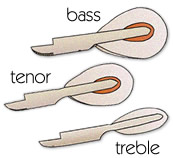
The Action
The Hammer
The hammer is the part of the action that makes the piano unique from other keyboard instruments such as the harpsichord and clavichord.
The Hammer begins its movement when the jack and repetition lever push up on the hammer knuckle. The knuckle has an outer layer made of leather (1), and an inner felt core (2). The hammer shank (3) rotates on the hammer flange (4), which is secured to the hammer flange rail (5). The hammer continues to be pushed up until the repetition lever comes into contact with the drop screw (6), which may also be called the repetition screw. At this point, the hammer continues toward the string on its own inertia - it is no longer under the influence of any other part of the action - this is called the escapement. The hammer head, which is made of felt (7) glued to the wooden hammer head molding (8), strikes the string and immediately rebounds in the opposite direction. The tail (9) of the hammer is caught by the back check and the hammer's motion is stopped. When the key is released partially, the hammer is pushed back into position by the repetition spring - this repositioning of the hammer is called double ecapement.

The hammers come in a range of sizes. The hammers on the bass end of the piano are the largest - they must have a larger mass in order to move the heavier bass
strings. The hammers gradually decrease in size as they move towards the treble range of the keyboard. The hammers at the far treble end are considerably smaller and
more pointed than the bass hammers. Over a period of time, the felt on the hammer head can become compacted from repeatedly striking the wire strings. When the una corda pedal is depressed, the hammers and action are shifted to the right, allowing the hammers to
strike the strings with a different portion of the hammer head felt, resulting in a difference in tone. A piano technician can use a special tool to soften the felt of
the hammer head - this is called voicing.
![]()
Follow the link to watch an animation of the hammer in action...
